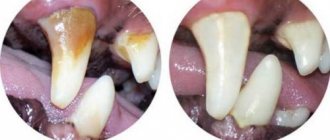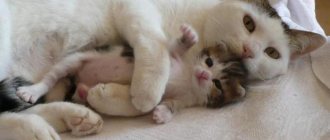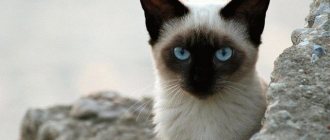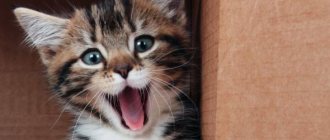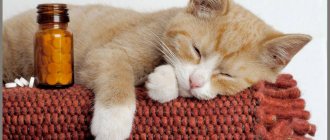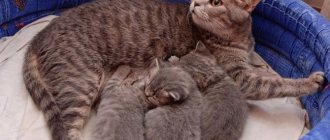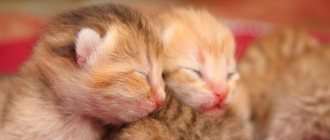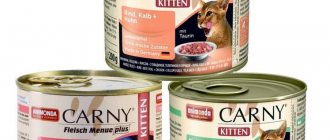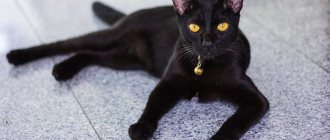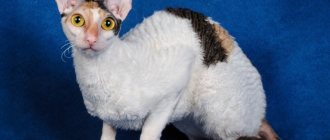When do kittens' baby teeth change?
Kittens' teeth begin to change between three and four months of age.
Sometimes this process can be delayed even up to five months of age. In any case, it will begin sooner or later, but the sooner it ends, the better. This is due to the peculiarities of the formation of the animal’s jaw. When baby teeth are replaced late by molars, the bite may develop incorrectly. During the period of changing teeth, the kitten becomes restless, begins to meow and in every possible way demonstrate to the owner that he is experiencing discomfort. At the same time, he begins to chew absolutely everything that is within reach: wires, books, children's toys, pencils, the backs of chairs and even the hands of the owners.
When a kitten shows signs of replacing baby teeth with molars, it needs to be provided with proper nutrition. Try to give your pet maximum attention during this time, never deny yourself the pleasure of cuddling and stroking him. This will help your child get through a difficult period easier.
If not all of your pet's baby teeth have fallen out, and the growth of the molars is already coming to an end, it is best to contact your veterinarian to have them removed.
Is it scary that a cat has no teeth?
A cat's lack of teeth is a negative phenomenon that can make serious adjustments to his life. He can no longer hunt and defend himself from the attacks of his younger and stronger relatives, and can only eat soft food.
It is advisable to keep an elderly cat that has lost teeth at home, and, if possible, not let it go outside. You never know who he will decide to fight with, or, on the contrary, who will attack him. The consequences in both cases can be disastrous.
You'll have to reconsider your pet's diet. The cat is a carnivore, which means it needs meat. But he can no longer chew its fibers on his own. The solution can be found by giving it to the cat in a rolled and ground form.
How many teeth should an adult cat or kitten normally have?
The number of teeth in mature representatives of this family does not depend on gender, age and breed. Some people mistakenly think that tooth loss in older animals is normal.
However, even in old age this should not happen, otherwise we are talking about some internal or external problem. Adult healthy cats and cats have 30 teeth, each of which performs a specific function.
Information about this is presented in the table:
| Permanent cat teeth | Number of dental units, pcs. | Function | |
| On the lower jaw | On the upper jaw | ||
| Incisors | 6 each | Capturing prey | |
| Fangs | 2 each | Tearing food | |
| Premolars | 6 | 4 | Grinding food |
| Molars | 2 each |
In these animals, a phenomenon such as pseudopolyodontia is occasionally observed - an increase in the number of teeth due to the loss of milk teeth. The veterinarian solves this problem. Due to a congenital anomaly or some disease, a cat may have incomplete dentition.
Anomalies in the development of the dentition
Dental abnormalities in cats have been less studied than in dogs. But a sufficient number of possible anomalies of the dentition and bite in cats have been described:
- Oligodontia is an abnormal development of the dentition, in which one or more teeth are missing. Primary and secondary oligodontia are diagnosed. In the primary case, the tooth germ is reabsorbed as a result of injury or disease. Secondary oligodontia is the loss of teeth that have already appeared. A variant of the norm is the absence of a second premolar of the upper dental arcade in a cat. This anomaly occurs in almost half of cats. In representatives of the Siamese and Oriental breeds, permanent canines may be completely absent or develop almost imperceptibly.
- Polydontia – duplication of teeth. This anomaly is very rare. False polydontia, a delayed loss of baby teeth, is more common. In order not to disturb the position of permanent teeth, retained milk teeth must be removed.
- Convergence is when teeth are too close in a row and overlap each other. In this case, the dentition shifts, the natural cleaning of the teeth is disrupted, and caries occurs.
- Retention is an anomaly in which the roots of the teeth are located far from each other.
- Progenia or “underbite” is a malocclusion that occurs due to underdevelopment of the lower jaw. A pronounced degree of progeny is considered if the teeth of the lower jaw extend beyond the upper row by more than 2 mm. With this anomaly, injury to the lower fangs of the palate is possible.
- Prognathia or overshot – observed when the upper jaw is underdeveloped. The upper row of teeth overlaps the lower one. If the closure discrepancy is more than 2 mm, then the degree of anomaly is severe. This malocclusion interferes with the normal grasping of food and its grinding.
- Twist is a misalignment of the jaws caused by a violation of the location of individual bones of the facial skeleton. Most often, the anomaly occurs in representatives of the Persian, Scottish, Burmese, and British breeds.
Malocclusions are grounds for disqualifying a cat. Violation of the composition of the dentition and malocclusion lead to dental diseases. Healthy cat teeth should be free of stains, tartar, chips and cavities. In order to monitor the health of a cat's teeth, the owner must know the signs of their pathology.
Dental problems and methods for solving them
Unfortunately, cats, like people, are familiar with the dentist. Despite their seemingly healthy lifestyle in comfortable conditions, or perhaps because of it, they are tormented by caries. Over time, teeth lose their whiteness, become covered with plaque, and tartar forms, leading to their loss. Sometimes the fault lies with the owners themselves. By feeding our beloved pet soft pastes and limiting solid food, we deprive him of his usual tools for cleaning plaque. In nature, when hunting and gnawing on prey, cats automatically brush their teeth and maintain the balance of microflora in their mouth.
Solid foods, such as dry food, can help prevent tartar buildup in cats.
But it is not necessary to take your cat out hunting if problems are detected. We can help our furry friends ourselves. It is necessary to constantly examine the animal’s mouth, and at the first sign of any violations, contact a specialist.
A proper diet or special hard treats will prevent the formation of tartar. And of course, brushing teeth should be mandatory for your pet. In this case, not our human toothpastes are used, but special ones - with a trust-inspiring smell and taste (fish, chicken or something else that tailed animals might like). A cat, like a person, must be accustomed to this procedure from childhood, then it will become, although not the most pleasant, familiar.
Brushing your cat's teeth will prevent tartar from forming.
If you are unable to brush your pet’s teeth at home, then you will have to go to the veterinary clinic. There, dental plaque is removed using ultrasound using a special device - an ultrasonic scaler. The amplitude and frequency of vibrations are selected on it, allowing you to easily remove tartar from the surface of the tooth without damaging the enamel. Although this is painless for pets, it is still quite unpleasant. And if a loving owner could not convince the cat to brush its teeth, then the doctor, valuing his life, will not even try to carry out such procedures without anesthesia. The price of a snow-white smile will be severe stress for your pet, not to mention a bill from the clinic.
Development and appearance of baby teeth
Newborn kittens have absolutely no teeth, otherwise the mother risks being bitten while feeding.
Milk teeth, like those of children, fall out in kittens at a certain age.
The first of them erupt already in the second week of the kitten’s life. First, the incisors come out, and the kitten’s fangs appear within 3-4 weeks. The kitten manages to acquire all its milk teeth by 2-3 months, and sometimes earlier. At this point, he can already chew small pieces of meat on his own.
Note! Dairy, unlike permanent, have greater sharpness and subtlety at the base. Molar cat teeth are not thinned at the gums
Then, after 3-4 months, the kitten rapidly changes its milk teeth to molars. Often this process goes unnoticed by the owner, because the kitten’s teeth are very small. Sometimes he can swallow a lost tooth; this is not dangerous to his health.
Formation and structure of the jaw
Most often, a cat's jaw is quite well developed and has one feature: its movement occurs only in the vertical direction. Cats seem to cut incoming food with their sharp teeth. The upper and lower jaws are symmetrically positioned relative to each other.
The structure of teeth in animals is almost the same as in humans. Each cat tooth has pulp, dentin, tooth enamel and a root. The placement of a cat's teeth is quite simple.
- There are 12 incisors located in front, which are mainly intended to hold prey in the mouth and cut food before swallowing.
- A little further along are very long fangs: two of them are at the top, and two at the bottom. They are intended for grinding food, and are also needed by cats for self-defense. In a fit of aggression, a cat can even bite a person’s hand.
- Behind the fangs are premolars - these are short and fairly wide teeth. On each side there are 3 premolars above and 2 below.
- The outermost teeth - molars - are located deep in the jaw. There are only 4 of them: 2 on top and 2 on bottom - one in each corner.
The incisors cut first, then the canines form. This happens 1 month after the kitten is born. Immediately after their formation, and in some cases simultaneously with the canines, premolars begin to appear. The last to come in are the molars.
Reasons for loss
Examining your pet's oral cavity will help you find out not only whether all the teeth are in place, but also in what condition they are. To do this, the pet is placed on a well-lit, stable table. A quick inspection only takes a minute or two. Most pets are comfortable with this procedure.
But before you open your cat's mouth, inspect its face for swelling. Often a broken upper fourth premolar will cause an abscess that can spread to the area under the eye. Fractures of the upper canines (or eye teeth) can also cause swelling of the upper part of the nose. Next, feel your neck below your ears. Abnormal swelling of this area may occur due to infection, cancer, or inflammation.
The main causes of tooth loss are:
- The natural aging process of a pet. Compared to humans, cats have better dental apparatus: a thicker protective layer of enamel and less destructive saliva. Cat food contains no sugar, and food particles are less likely to get stuck between teeth. And yet, as they age, they lose teeth. Cats usually adapt quickly to tooth loss and can cope with food even if some or all of their incisors are missing. Some cats can still eat dry food even if all their teeth have fallen out.
- Changing teeth in kittens. As a rule, the absence of a tooth does not cause any inconvenience to the baby.
- Oral diseases. Lack of regular cleaning can lead to loose teeth and periodontal disease. Due to the accumulation of bacterial byproducts on the gums, the bone that holds the teeth in their sockets is destroyed. The teeth begin to loosen. Not only does this make it inconvenient for your cat to eat, but she may end up with loose teeth. The incisors are usually affected before the back teeth.
In addition, a cat can lose teeth by grabbing something hard or in a fight with other animals (cats, dogs). Also, the cause of tooth loss can be injury (fall from a height, blow to the jaw).
Stomatitis
There is growing evidence that various organs of the body can be affected by bacteria and toxins that enter the body through the bloodstream from the mouth. Chronic inflammation in a pet's mouth can cause problems such as elevated liver enzymes, heart disease, kidney disease and diabetes.
How to prevent problems?
Your pet's teeth will be healthier if they are brushed regularly.
The prevention procedure is long. Inspecting the oral cavity at least once a year is the main preventative point for dental pathologies, and the basis for preventing diseases is following the recommendations:
- Brush your teeth daily at home.
- Remove yellow plaque using a cotton swab dipped in hydrogen peroxide.
- Introduce food with a coarse structure into the diet, which helps to avoid the accumulation of food residues.
- Maintain your pet's health and prevent possible injury from a fall.
In order not to injure the pet, all manipulations with cleaning the dentition are carried out with the animal well fixed. It is important to understand that only an integrated approach: properly selected nutrition, care for the oral cavity and the general condition of the pet will maintain the animal’s dental health in perfect order.
How to determine age by teeth
Felinologists without any problems determine the age of a furry pet by the number of teeth and the condition of the incisors and canines. For this purpose, a special technique has been developed that allows you to determine the age of the animal with an accuracy of up to six months. Main features:
- 30 even, snow-white teeth indicate that the animal has just turned one year old.
- If the teeth are slightly yellowed, then the cat is about 1.5 years old.
- By the age of two, the lower incisors wear down a little. On the rest you can see a clearly visible yellowness.
- The front incisors that have begun to wear off indicate that the animal is approaching the three-year mark.
- Fangs begin to change by the age of five. In addition, by this age, a pronounced dark yellow coating most likely appeared on them.
- After five years, the destruction of the surface of the incisors begins, this is especially noticeable by the age of 7-8 years.
- By the age of ten, the gums weaken, so teeth begin to fall out (first the lower and then the upper incisors).
- If there is no longer a single incisor in the mouth, then the cat is 12-14 years old. This is quite an advanced age for an animal.
- The fallen fangs indicate that the cat is about 15 years old.
How many teeth a cat will have depends on the pet’s lifestyle and the quality of its diet. Much depends on the person - the lack of any care can speed up the process of hair loss.
Teeth instead of a passport, or how to find out the age of a cat
It is by the teeth that you can determine the age of a pet. Their number and condition will tell a specialist a lot. Here are the age-related changes that occur to cat teeth:
- 2–4 weeks—baby teeth erupt;
- 3–4 months – the process of changing baby teeth begins;
- 5–7 months – the replacement of baby teeth with permanent ones ends;
- 1 year - healthy cats have snow-white teeth, without signs of tartar;
- 2 years - the middle incisors on the lower jaw are gradually worn away, the enamel turns yellow, and tartar forms;
- 3–5 years - the process of abrasion of the central incisors on the upper jaw, the outermost ones on the lower jaw and canines begins;
- 6–7 years - the pigmentation of tooth enamel is disrupted, the outer incisors of the upper jaw begin to wear off;
- from the age of 10, tooth loss begins - first the central incisors, then the middle and outer incisors;
- By the age of 15–18 years, a cat loses its fangs.
But don’t worry, the time at which these processes begin depends very much on the health and lifestyle of the particular cat, and the main role is played by the quality of care from the owners.
Teeth tell everything about a cat's age instead of a passport.
Causes of diseases
All cat teeth are small in size and very sharp. They can suffer physically from various incidents, for example, it is not uncommon for a cat to have a broken tooth due to eating the wrong food or due to injury. The main causes of damage to teeth are impacts; they are knocked out during falls and accidents with vehicles.
Sometimes the cause of breakage and serious damage is bones that accidentally end up in cat food, or this happens when a cat eats a caught mouse or bird.
Usually, after such incidents with the cat’s teeth, roots are left that are easily inflamed and painful. When asked what to do in such a situation, it can be recommended to contact a veterinarian and remove the remains, since they will most likely bother the animal and will soon cause inflammation of the gums.
In addition to mechanical damage, the following conditions or diseases can cause problems:
- Genetic predisposition. Most often, structural defects and a tendency to disease are found in cases where the cat belongs to a breed obtained as a result of human selection efforts.
- Pathologies of location. Some breeds are missing one or two teeth, which negatively affects the functioning of the entire apparatus.
- Improper or insufficient nutrition. This has a particularly negative effect on the condition of the bones and teeth of kittens if their mother was malnourished or starved during pregnancy, or if they received poor nutrition in the first months of life. In the future, disruption of the structure and functions of the oral apparatus can be provoked by monotonous, poor food with insufficient amounts of vitamins and minerals.
- Bad ecology. A cat, like a person, will suffer from poor quality water, polluted air and artificial chemical food.
- Infections. They cause inflammation of the gums and tooth tissues, causing it to become loose in the socket, and a swaying tooth can easily break or simply fall out. Sometimes tooth resorption occurs due to infection in domestic cats.
- Insufficient oral hygiene. Plaque that is not removed in time turns into hard tartar, which injures the gums, causes inflammation and causes putrefactive processes and tooth loss, as well as many diseases of internal organs.
INTERESTING TO FIND OUT: Why does a cat lose teeth?
Since there are many reasons for a cat's oral cavity, owners will need to monitor it closely to catch problems early.
Cat dental diseases
Pets may experience the following diseases:
- Caries: occurs when the enamel is chipped or tartar forms.
- Osteomyelitis is a continuation of caries. An abscess develops.
- Periodontitis: the root of the dent is destroyed and it falls out.
- Gingivitis is inflammation of the gums. Develops as a result of improper structure of food, particles of which stick to the gums. Plaque is formed, which turns into stone - dentolite.
Dental pathologies are characterized by the following symptoms:
- the pet rubs its cheeks on objects;
- hits himself with his paws;
- halitosis develops - a stench from the mouth;
- loss of appetite because it hurts to eat4
- gums turn red;
- a yellow or brown coating appears;
- salivation develops.
The above symptoms are grounds for seeking veterinary help.
Brushing and caring for your teeth
In order for your pet to remain in excellent physical shape until old age, you must not only feed him fresh, good-quality foods and regularly carry out hygiene procedures, but also pay special attention to the condition of his teeth. After all, healthy, strong teeth are the key to animal health.
They help to capture and chew large pieces of prey well (even if it is taken out of the jar and placed in a bowl by a caring owner), which, in turn, promotes normal digestion.
Regular teeth cleaning, carried out according to all the rules, prevents the formation of tartar, which consists of salts, food and bacteria, strongly hardened and deposited in the area of the roots of the teeth. The vital activity of bacteria causes inflammation of the gums, their detachment, as a result of which the necks of the incisors and canines are exposed. It becomes painful for the animal to chew, and his breath smells bad. Discomfortable phenomena are accompanied by loss of appetite, and as a result, loss of body weight. Very often, teeth affected by stones fall out prematurely.
Nothing like this will happen if the cat’s diet contains solid food that helps mechanically clean the teeth. In addition, your cat's teeth need to be brushed regularly.
The sooner you start getting your pet used to brushing its teeth, the better. Then, having become accustomed to such a procedure, the animal, upon becoming an adult, will not resist. However, experienced cat owners often manage to accustom cats that come to them at a fairly mature age to do this. By the way, cats calmly accept many not very pleasant procedures, intuitively feeling that the owner cares about their health.
You can clean your cat's teeth using:
- a clean finger wrapped in a bandage or gauze;
- a soft toothbrush intended for children;
- a special brush attachment that is used to clean the teeth of small animals.
Our toothpaste is not suitable for cats. Purchase a special cleaning paste for your pet at a pet store. Such pastes are completely harmless, easy to use, do an excellent job of cleaning teeth, cats like the taste and smell, and most importantly, do not require rinsing.
Don't rush to start cleaning right away. Let your pet get used to the taste of the paste - just place it on the animal’s cheek. After a day or two, apply a very small amount of paste to the brush and try brushing the animal’s teeth with it. Don’t be upset or despair if even your pet breaks out of your hands and scurries under the sofa. Remember how you hated brushing your teeth as a child, but over time you got used to it! Don't back down. Soon the cat will understand that brushing his teeth is included in the list of daily procedures along with eating or going to the toilet, and he will come to terms with the inevitable.
The first brushings may only last a few seconds, but as your pet adapts a little, increase these hygiene procedures to two or three minutes. Just don't go too hard. Your goal is only to remove plaque from your teeth.
The most convenient way to brush a cat's teeth is to turn his back to you, using the same movements as if you were brushing your teeth.
Functions
Cats need whiskers for the following purposes::
- hunting,
- communication,
- orientation.
It is known that when hunting, a cat uses not only its hearing organs. If a cat bends down to the ground and touches it with its hairs, then it feels even the slightest vibration that the mouse's paws emit. When the “hunter” begins to run and the flow of air ripples the hairs, the cat already understands in which direction the prey ran. But even this is not the end of the hairs’ function. After the prey is caught, the hairs wrap around the body and the cat determines whether the prey is dead or not. When the victim is alive, that is, it is still early, the rodent can bite the cheek. And this method of determination occurs not only with the mouse, but even with food in the bowl.
The reliability of the information depends on how many whiskers the cat has. You can take a closer look if you give the cat a treat. She will move her antennae forward. This is how she analyzes whether the food is attacking her.
It happens that cats' whiskers break. This is due to the active use of the mustache when navigating the terrain. In addition to the fact that the cat sees well, it uses its whiskers as an aid. The hairs are pressed to the ground when moving. Even if it is completely dark, a cat is able to find its own route with such a “night vision device.”
© shutterstock
If a person pays attention to a cat’s whiskers when it communicates with another cat, then he will definitely understand how the animal is configured. If the mustache is extended forward, then she does not mind getting to know her brother. If the mustache is spread to the sides, then this is a sign - “do not approach.” If the hairs are pressed tightly to the muzzle, it means the cat is scared.
Changing baby teeth to permanent ones
At the age of three months, kittens begin to lose their milk teeth, gradually being replaced by molars. This process is usually complete by six or seven months, but don't worry if it takes longer for your kitten. Such deviations are usually associated with the breed of cat or characteristics of individual development.
However, if a new tooth grows on a baby tooth and this causes discomfort to the pet, then you should definitely consult a specialist. If such growth does not bother the animal, then a visit to the veterinarian can be postponed, since baby teeth can calmly and painlessly fall out even after the main shift.
Teeth change schedule
A healthy adult cat should have thirty permanent teeth: twelve incisors, four canines, ten premolars and four molars. Each of them serves her for a specific purpose, for example, incisors are needed to tear food, fangs help to capture prey, and so on.
A cat's permanent dental formula is formed after six months. It includes: on top - three incisors, one canine, three premolars, one molar; below - three incisors, one canine, two premolars, one molar. When calculating, all coefficients are doubled, so the total is thirty permanent teeth.
This is what the jaw of an adult healthy cat should look like with timely and correct teeth replacement.
Table: schedule for the eruption of permanent teeth and their functions
| Teeth | Quantity (lower/upper jaw) | Period of eruption | Function |
| Incisors | 6/6 | 3.5–4.5 months | Grabbing |
| Fangs | 2/2 | 5 months | Tearing |
| Premolars | 6/4 | 4.5–6 months | Chopping |
| Molars | 2/2 | 4–5 months | Chopping |
Symptoms of tooth change
The process of changing teeth can begin and even end unnoticed by you, since the kitten usually does not experience pain. Most often, the change of teeth becomes obvious when a lost baby tooth is found.
Nevertheless, there are a number of symptoms that will help you navigate and notice in time the process of changing teeth:
- When a kitten's teeth change, an unpleasant odor may appear from the mouth, which is often associated with poor nutrition. There is no need to do anything about this, it will quickly disappear once the teeth renewal process is completed.
- Kittens may experience discomfort during the actual cutting of new teeth, so the animal's behavior will change slightly. For example, a slight increase in temperature is likely (the norm is a temperature of 38 ° C to 39 ° C, for small kittens a higher temperature of up to 39.5 ° C is typical). As a result, the kitten feels the cold more strongly and tries to spend more time next to the warm body of the owner: on the lap or in the arms. At night, pets can crawl under the covers, even if this was previously uncharacteristic for them.
- You need to carefully ensure that the kitten does not swallow a lost tooth while eating. If this happens, you should not immediately run to the veterinarian; usually the tooth comes out naturally. However, it can also get stuck in the intestines, causing pain. The kittens then become aggressive and their temperature rises. In this case, you need to contact a specialist.
- During the period of teeth change, the pet will more often try to taste everything or chew on it in order to get rid of loose teeth.
- From this moment on, cats begin to mark their territory.
- Redness of the gums may be observed, which is better to contact a specialist immediately so that chronic inflammation of the oral cavity does not begin.
- Sore gums can lead to refusal to eat. This is not a big deal, but if it lasts more than one to two days at most, you should change dry food to wet food, consulting your veterinarian first.
The author of these lines recently encountered the process of changing teeth in his kitten. Each animal exhibits specific symptoms, and when problems arise, it is easy for owners who know their animals to notice changes in behavior. So, my kitten usually did not hide under the blanket and did not play with some toys. When his teeth changed, he constantly chewed rubber sticks and tried to bite the scratching post. In this case, the baby teeth did not fall out immediately, but after the fangs were replaced.
Dental apparatus in adult cats
After 3–6 months, animals begin the process of replacing dairy products with permanent ones. Animals do not experience pain during this period. The places where baby teeth grow begin to itch, so the kittens begin to chew everything that comes into their field of vision. Cats' baby teeth begin to become loose and fall out unnoticed. The deciduous incisors are the first to fall out.
Almost immediately they are replaced by permanent ones. They are slightly different in color and structure from temporary ones. Unlike milky ones, permanent ones are not as white in color. They do not exhibit milky transparency. They are more dense in structure and larger in size.
It often happens that the milk one is replaced by a permanent one, but it has not yet fallen out. New teeth in cats grow rapidly and quickly increase in size. In this case, it is advisable to visit a veterinarian with your pet so that he can help the animal.
Sometimes the process of changing temporary to permanent teeth occurs with complications. Inflammatory processes can occur in your pet's oral cavity, so you need to periodically look in and inspect his mouth. If there is an inflammatory process, swelling is noticeable and the color is slightly darker than usual, then medical attention is needed.
How many teeth does a cat have?
The dentition of an adult cat is not very different from a small kitten with teeth. Very quickly the baby teeth are renewed, and the animal only has permanent ones. Their total number is 30 units. 16 units grow in the upper jaw, and 14 units grow in the lower jaw:
- 12 incisors;
- 10 premolars;
- 4 fangs;
- 4 molars.
Since the animal’s immunity weakens during the period of dental changes, veterinarians do not recommend vaccinations for cats. An adult cat's jaw is now fully formed and will no longer change.
Oral care
Caring owners should periodically inspect the mouth of a small predator. If the cat’s teeth are in order, he will be able to easily grab a piece of food and chew without harming his health. The condition of the dentition always depends on care and timely removal of tartar.
Residues of food and salts on tooth enamel contribute to the formation of tartar. They are mainly localized in the root area. For this reason, the gums become inflamed due to bacteria. The gums begin to gradually peel off and expose the neck of the canine or incisor. Pain and unpleasant odors appear in the oral cavity due to infection. In this condition, teeth quickly decay and fall out. It is difficult for a pet with bad teeth to handle food and chew it. The cat loses its appetite and it loses weight.
The kitten should be accustomed to this procedure while it is still very small. Cleaning is done using a bandage wrapped around a finger or a toothbrush for children. There are also special attachments for small animals.
Special cleaning products are sold in specialized stores. They are safe for animal health and have an attractive taste and smell for the animal. After the cleansing procedure, they do not need to be washed off with water.
The incisors bear the main load, so they wear out faster than other teeth. The rest are preserved for 20 years. Strong and healthy teeth for a cat will help her stay healthy and active, in a good mood.
How many teeth do kittens have, what do they look like and what are they called?
Normally, each kitten should have 26 teeth: 12 incisors, 4 canines, 10 molars. The baby does not have such a number of teeth from birth. Babies are born toothless. Their first teeth begin to erupt at 7–14 days of age (the sequence of their eruption is presented in the table below).
This process is completed by 2 months. If by this age your four-legged pet is missing one or more teeth, you should show it to the veterinarian, since this phenomenon may be a symptom of a serious illness.
| Baby teeth | Numbering | Timing of eruption, weeks |
| Incisors | I | 2–3 |
| II | 2,5–4 | |
| III | 3–4 | |
| Fangs | ||
| Premolars | II | 8 |
| III | 4–5 | |
| IV | 4–6 |
How many teeth and what kind of teeth does a cat have: Milk teeth in cats
Around the third week of life, kittens begin to develop temporary teeth. The process is accompanied by profuse salivation and an active desire to rub against anything. Milk teeth in cats are usually called temporary, since their lifespan is very short. They change literally up to six months.
The schedule of their appearance is always very consistent:
- By about a month, the kitten becomes the proud owner of front incisors.
- After another two weeks, the first fangs appear.
- Premolars are cut up to 3.5 months.
In fact, baby teeth are very sharp. They cause a lot of inconvenience to the cat. At this age, kittens develop an interest in research. They happily chew on everything that comes their way.
Starting from a month, it is necessary to introduce complementary foods. This is done not only because of the body’s growing needs for calories, but also to develop the muscles of the face and the formation of the correct exterior.
The appearance of teeth in cats occurs unnoticed by others. The kittens do not experience any pain or discomfort.
In the most extreme case, kittens begin to change teeth at the age of 3 months. This is typical for breeds that develop quickly and become adults quite early. For example, sphinxes, which by the age of six months are often ready to reproduce. On average, in all cat breeds, the replacement of baby teeth occurs in the fifth month of life.
Complete formation of the jaw apparatus occurs at the age of about six months.
The sequence of replacement of baby teeth is the same as their appearance:
- First, the temporary incisors are replaced (at about 3-5 months).
- Then permanent fangs grow in cats (not earlier than 4-5 months).
- Molars and premolars are the last to be replaced (permanent teeth grow from 4 to 6 months).
During the period of changing teeth, you need to monitor their number and condition of the oral cavity. The mucous membranes should have a healthy pink color, without deviations. The presence of blood on the gums, displacement of the teeth relative to the jaw axis is a reason to consult a veterinarian. Otherwise, the kitten’s exterior may not develop properly, which will certainly affect its overall health in the future.
Often during the period of teeth change, the owner may feel that the kitten is behaving aggressively: biting and scratching.
It is important not to miss this period and be sure to introduce solid foods into your diet. Dry food and treats, as well as rough meat by-products, will help the kitten survive the change of teeth adequately and without problems
Milk teeth in cats 26 pcs.
- 12 incisors
- 4 fangs
- 10 premolars
Incisors – the front teeth of cats, there are 12 of them.
Fangs are the teeth next to the incisors; cats have 4 of them.
Adult cats also have molars – wisdom teeth. They are only radical, located last.
Little kittens are trying to help themselves with teething, therefore, like children, they chew everything that comes into their mouth. At this time, you need to be careful - remove all small objects, such as buttons, beads, etc. Kittens can not only damage their delicate gums, but also choke.
A little later, after three months, cats’ teeth change, and cats’ milk teeth fall out. Read about tooth loss in kittens here.
After reaching 3 years of age, more than 80% of domestic cats suffer from dental ailments. But, as you know, the first incisors appear in newborn babies a couple of weeks after birth. Kittens at 10 weeks of age have a full set of teeth, amounting to 26. After 1.5-2 months, milk teeth begin to be replaced by permanent ones. The process itself is almost painless, although in some cases changing incisors and fangs can cause significant discomfort to the cat.
During this period, the animal’s body produces a special substance in saliva - lysozyme. It helps prevent oral infections by providing an antibacterial effect. Due to poor nutrition and lack of the required amount of useful vitamins and microelements, lysozyme may become insufficient.
First of all, you should know that there are 16 bone formations on the upper jaw of an adult cat, and 14 on the lower jaw. They usually erupt in the following sequence:
- At the age of 3-4 months, the incisors appear.
- After 2-3 weeks, new fangs can be noticed.
- Another similar period of time will allow us to detect chewing premolars, and then molars.
The structure of cat teeth: diagram, replacement order
Kittens are born without teeth (dents). The milking period lasts about one and a half months, so the cubs should be ready to eat solid food before weaning.
In adult animals, the following groups of dents are distinguished:
- incisors;
- fangs;
- premolars;
- molars or molars.
In two-week-old babies, temporary or baby teeth erupt. At two weeks of age, the incisors appear. The first fangs cut through the gums of twenty-day-old kittens. At the same age, premolars appear, which reach full development by 40 days. That is, the weaned kitten has solid food to chew on. A two-month-old baby is already armed with 26 teeth.
The structure of cat teeth: diagram
A 100-day-old teenager begins to grow permanent teeth, which push out the baby teeth, and they fall out. The replacement of lactate dents with permanent ones occurs in the same order: first the incisors, then the canines and premolars.
By four months, the first molars appear. These are permanent dentures. The change in most young cats ends by the age of six months; by this time there are thirty teeth.
How to feed an animal whose teeth have fallen out or been removed (all or several)?
The diet of an animal that for some reason has lost one or all teeth should consist exclusively of soft food. It can be fed wet ready-made or pre-soaked dry food. Do not use broth or milk to soften the granules. It can only be soaked in water whose temperature does not exceed 30°C. Under the influence of hot liquid, the proteins contained in dry food are denatured, ascorbic and folic acid, thiamine, carotene and riboflavin are destroyed, and vitamins A, D and E are oxidized.
Cat food should be at room temperature. Too hot or cold food is contraindicated for animals with sensitive gums.
Dental services
Typically, veterinary clinics provide cats with dental services such as tartar cleaning and removal of baby and molar teeth.
Brushing a cat's teeth is a procedure that can be done at home by the owner. However, in some advanced cases, plaque on the teeth cannot be removed with a special toothbrush and cat paste and you have to go to the veterinarian. There are two methods for its removal - mechanical and ultrasonic.
In the first case, the animal is subjected to general anesthesia, after which the deposits are scraped off using special instruments. Unfortunately, this can damage tooth enamel, which will inevitably lead to tooth decay in the future. In addition, an inexperienced doctor can damage your pet's gums, after which long-term treatment will be necessary.
The second method of removing plaque involves treating the animal’s oral cavity with ultrasound emitted by a special apparatus. This is a completely painless procedure that often does not require general anesthesia. Unfortunately, it is quite expensive and requires equipment that may simply not be available at your local veterinary clinic.
The kitten's baby teeth are also removed under general anesthesia. In the hands of professionals, this procedure is completely painless and helps prevent the animal from developing an incorrect bite and such a serious disease as periodontal disease.
Molars should be removed only as a last resort: if they are seriously damaged or the animal has developed a serious oral disease - for example, a dental abscess. This is also done under general anesthesia, but, unfortunately, the operation is often poorly tolerated by animals, so it is resorted to only as a last resort if there is a risk to the life and health of your pet.
Regular brushing will help keep your pet's teeth strong and healthy into old age. Don't neglect this. Then your pet's life will be long, happy and comfortable.
Care Tips
Dental problems invariably lead to digestive disorders and health problems. The most common pathologies caused by diseases of the oral cavity are flatulence, dysbacteriosis, and impaired peristalsis. Veterinarians recommend:
- Provide adequate nutrition - a lack of phosphorus, calcium and some other microelements provokes accelerated tooth decay. Therefore, it is important that your cat has enough dairy products in his diet.
- Giving cartilage, flat spongy bones, and raw meat from time to time strengthens the gums and helps cleanse teeth of dirt.
- Periodically visit a veterinarian and examine the oral cavity. If necessary, heal the resulting problems.
- Buy special bones-delicacies. As an alternative, you can offer chicken cartilage - all this effectively removes tartar and plaque.
A lot depends on the kitten’s diet when its first incisors are just beginning to emerge. At this time, it is important to monitor proper nutrition and buy, if possible, specialized feed that contains the microelements necessary for full growth and development. And also try to remember how many teeth a cat should have in order to contact a specialist in a timely manner.
Many owners do not neglect even such a procedure as oral hygiene. In particular, you need to clean even newly erupted teeth using a special brush and unscented cleaning powder. However, keep in mind: cats are extremely averse to such procedures. If you wish, you can contact a veterinary clinic, where they will perform cleaning using one of the methods: chemical, ultrasonic or mechanical. The animal falls asleep under the influence of sedatives, and at this time the necessary manipulations are performed.
Determining the age of the kitten
First, we should talk about how to determine the age of a kitten by its teeth. Babies are born without teeth, which allows them to avoid damaging the mother’s tender nipples. And since they feed on mother’s milk until about one month of age, the first milk teeth begin to cut at 3-4 weeks of their life.
The following table will help you determine the age of your little pet.
| Kitten age | Teeth |
| 3-5 weeks | Primary incisors begin to cut |
| 4-8 weeks | Baby fangs begin to cut |
| 5-10 weeks | Primary molars begin to erupt |
| 6-12 weeks | Primary premolars begin to erupt |
| 3-6 months | Baby teeth begin to be replaced by permanent teeth |
| 5-7 months | Molars begin to erupt |
Quite often it is visually quite difficult to discover that a cat’s first baby teeth are beginning to erupt. In this case, it is recommended to carefully feel the pet’s gums. And if this process has already begun, then you can feel minor pricks with your fingertips, as if from small needles. The primary canines will cut next to the incisors; these teeth have a long, pointed shape.
By the age of four months, the kitten should have:
- on the upper jaw there are 6 incisors, 2 canines, 3 premolars;
- on the lower jaw there are 6 incisors, 2 canines, 2 premolars.
If the kitten has large teeth, then it is more than 4 months old
Features of changing teeth
Now let's figure out when kittens change teeth. This happens as follows:
- first of all, the incisors are replaced by permanent ones, which happens at approximately 4 months;
- until the animal is six months old, canines, molars and premolars must be replaced;
- By the age of seven months, the kitten should have 4 molars and all molars.
However, this only applies to absolutely healthy animals. If some teeth are missing or their appearance is greatly delayed, this indicates the presence of some disease.
Milk and permanent teeth of cats
Kittens are born completely helpless - not only blind, but also toothless. At first, they don’t need teeth, given the dairy diet. The first incisors appear at 2–4 weeks of age, canines erupt at 3–4 weeks, and premolars at 3–8 weeks. This does not cause any particular problems for kittens. They just want to chew on something all the time, which, in the absence of specially designated toys, can cause problems for their owners.
The kitten tries to taste everything
Later, at about 3–5 months, the turn of permanent teeth comes. First, at 3–5 months, the incisors are replaced, then at 4–5 months, fangs erupt, and at 4–6 months, premolars, and last of all, molars grow - “wisdom” teeth, which small kittens do not have. Normally, the process of changing teeth ends by 7 months, and the kitten stops gnawing everything it sees and can reach, to the delight of its owners.
A cat has 30 permanent teeth
The structure of a cat's teeth is approximately the same as that of a human:
- The pulp is the inner part where the nerve cells and blood vessels are located.
- Dentine is the covering of the pulp.
- Enamel is a hard bone formation devoid of nerve endings.
Teeth play a larger role in the life of cats than in humans. If we mainly chew and grind food with our teeth, then a cat’s teeth are its deadly weapon. It is with sharp fangs that she kills prey, plunging them into its spine, and then tears the carcass into pieces. In principle, a cat is capable of digesting food anyway, swallowing large pieces.
Teeth are a cat's deadly weapon.
Full formation of the jaw and teeth in cats occurs at approximately 8 months of age. An adult has 30 permanent teeth. of which:
- 4 fangs (located in front).
- 12 incisors (short front teeth with a sharp edge).
- 10 premolars (long, single-rooted chewing teeth).
- 4 molars (similar to human wisdom teeth).
A cat's tooth is designed more for cutting hard food than chewing. After all, cats are predators by nature and their main prey are smaller animals. Therefore, all teeth are prematurely sharp and easily cut meat.
We invite you to read: All about the Russian Blue cat: features of appearance and character
A cat's tooth is formed from the following components:
- Pulp is a central cavity within which nerves and blood capillaries are located that nourish bone tissue.
- Dentine is a mineralized tissue that fills the space between the pulp and the outer shell. In fact, this is the main base of the tooth. Dentin is very hard, but sensitive, and is destroyed quickly if the top protective layer is damaged.
- Enamel – the outer white shell. The hard outer layer is not connected to the nerve endings and is therefore not sensitive. Enamel is the main protection of the tooth from external factors. If it becomes damaged or worn away, eating the food causes pain for the cat.
The arrangement of teeth in cats looks like this:
- Upper jaw – 2 fangs; 6 incisors; 6 premolars; 2 molars.
- Lower jaw – 2 fangs; 6 incisors; 4 premolars; 2 molars.
The age of a cat can be determined by its teeth. Very often, by the age of 5-6 years, the incisors of animals are already severely worn out, the enamel becomes yellow or even brown. By the age of 10-12 years, fangs fall out.
With the loss of fangs, the head skeleton of a predator may change - the upper jaw protrudes slightly forward, but this is not always so noticeable.
The teeth and oral cavity of animals are also susceptible to various diseases: caries, pulpitis, periodontal disease, gingivitis. Only, unlike a person, a cat cannot communicate its pain and suffers in silence.
A lot depends on food. Cats cannot be constantly fed soft food - their gums and incisors weaken. While chewing hard food, the enamel cleanses itself, and soft food, on the contrary, creates plaque and tartar, which destroy the structure of bone tissue.
To prolong your pet's dental health, you should be examined by a veterinarian at least once a year. Preventative visits will help prevent illness or detect problems at an early stage. As a rule, the teeth of domestic and well-groomed cats remain healthy much longer and fall out later.
